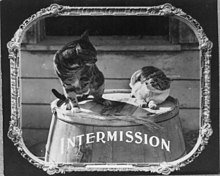
Back Антракт Bulgarian Intermedi Catalan Intermedio Spanish Väliaika Finnish הפסקה HE Intermissio Latin Intervalo (performance) Portuguese Intermission SIMPLE

An intermission, also known as an interval in British and Indian English, is a recess between parts of a performance or production, such as for a theatrical play, opera, concert, or film screening. It should not be confused with an entr'acte (French: "between acts"), which, in the 18th century, was a sung, danced, spoken, or musical performance that occurs between any two acts, that is unrelated to the main performance, and that thus in the world of opera and musical theater became an orchestral performance that spans an intermission and leads, without a break, into the next act.[1]
Jean-François Marmontel and Denis Diderot both viewed the intermission as a period in which the action did not in fact stop, but continued off-stage. "The interval is a rest for the spectators; not for the action," wrote Marmontel in 1763. "The characters are deemed to continue acting during the interval from one act to another." However, intermissions are more than just dramatic pauses that are parts of the shape of a dramatic structure. They also exist for more mundane reasons, such as that it is hard for audience members to concentrate for more than two hours at a stretch, and actors and performers (for live action performances at any rate) need to rest.[2][3] They also afford opportunity for scene and costume changes.[4] Performance venues take advantage of them to sell food and drink.[4]
Psychologically, intermissions allow audiences to pause their suspension of disbelief and return to reality, and are a period during which they can engage critical faculties that they have suspended during the performance itself.[2][4]
- ^ Charlton 1986, p. 128.
- ^ a b Pavis & Shantz 1998, p. 187.
- ^ Andrews 2011, p. 59.
- ^ a b c Goodridge 1999, p. 85.
© MMXXIII Rich X Search. We shall prevail. All rights reserved. Rich X Search